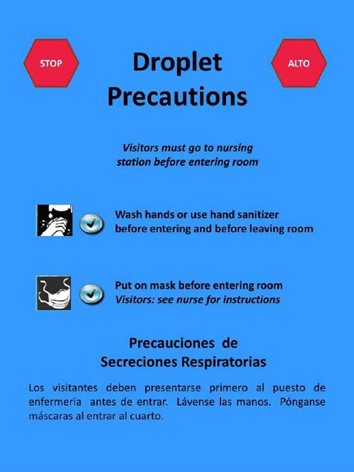A nurse in the emergency department is caring for a child who has a temperature of 39.1° C (102.4° F) and a suspected diagnosis of bacterial meningitis.
Which of the following actions should the nurse take first?
Prepare the child for a lumbar puncture.
Implement droplet precautions for the child.
Dim the lights in the child's room.
Administer an antipyretic to the child.
The Correct Answer is B
The nurse should first implement droplet precautions for the child.

Bacterial meningitis can be spread through respiratory and throat secretions, so it is important to take precautions to prevent the spread of infection.
Choice A is wrong because while a lumbar puncture may be necessary for diagnosis, preventing the spread of infection is a higher priority.
Choice C is wrong because while dimming the lights may provide comfort, preventing the spread of infection is a higher priority.
Choice D is wrong because while administering an antipyretic may provide comfort, preventing the spread of infection is a higher priority.
Nursing Test Bank
Naxlex Comprehensive Predictor Exams
Related Questions
Correct Answer is C
Explanation
A potassium level of.2 mEq/L is considered low.
Low potassium levels can cause muscle weakness and spasms.
Hyporeflexia refers to below normal or absent reflexes and can be a sign of muscle weakness.
Choice A is wrong because oliguria, or decreased urine output, is not a common symptom of low potassium levels.
Choice B is wrong because hypertension, or high blood pressure, is not a common symptom of low potassium levels.
Choice D is wrong because hyperactive bowel sounds are not a common symptom of low potassium levels.
Correct Answer is A
Explanation
Following the child’s home sleep routine can help reduce anxiety and promote adequate sleep.
Children thrive on routine and consistency, and maintaining their usual sleep routine can provide a sense of familiarity and comfort in an unfamiliar environment.
Choice B is wrong because leaving the lights on can disrupt the child’s sleep.
Choice C is wrong because allowing the child to adjust their bedtime may disrupt their sleep routine and lead to inadequate sleep.
Choice D is a good option, but following the child’s home sleep routine is the best way to promote adequate sleep.
Whether you are a student looking to ace your exams or a practicing nurse seeking to enhance your expertise , our nursing education contents will empower you with the confidence and competence to make a difference in the lives of patients and become a respected leader in the healthcare field.
Visit Naxlex, invest in your future and unlock endless possibilities with our unparalleled nursing education contents today
Report Wrong Answer on the Current Question
Do you disagree with the answer? If yes, what is your expected answer? Explain.
Kindly be descriptive with the issue you are facing.
